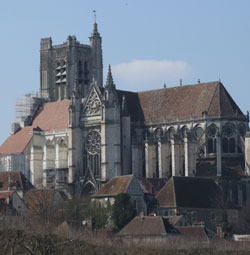
Feastday: May 16
Patron: against snake bites
Death: 3rd century
Canonized: December 27, 1726
First bishop of Auxerre in Gaul. Peregrinus was supposedly a Roman who received consecration as bishop from Pope Sixtus II in Rome and was sent to assist the evangelization of Gaul. He met with great success in the area around Massilia and Lyons, France. Most of what is known about him is legend, although there is no question that he was martyred under Emperor Diocletian in the late third century or early fourth century for interrupting a pagan ritual honoring Jupiter.
Saint Peregrine (Peregrinus) of Auxerre (French: Saint Pèlerin, Italian: San Pellegrino) (d. ca. 261 AD or ca. 304 AD) is venerated as the first bishop of Auxerre and the builder of its first cathedral. A strong local tradition states that he was a priest of Rome appointed by Pope Sixtus II to evangelize this area at the request of the Christians resident in that part of Gaul. He preached at Marseilles, Lyon, and converted most of the inhabitants of Auxerre to Christianity.
At Intaranum –present-day Entrains-sur-Nohain– Peregrine angered the governor after the saint appealed to the populace to abandon pagan idols; the inhabitants had been dedicating a new temple to Jupiter.
The Martyrologium Hieronymianum states that he was tortured and beheaded at vicus Baiacus (Bouhy) (in present-day Nièvre) during the persecutions of Diocletian.
His lector Jovinian, venerated as a saint, was also martyred with him. Other companions included Marsus, his priest; Corcodomus, his deacon; and Jovian his subdeacon.
Veneration
 St. Peregrine is said to have founded Auxerre's cathedral, Saint-Etienne.
St. Peregrine is said to have founded Auxerre's cathedral, Saint-Etienne.
Historians postulate that he was probably not a bishop at all, but rather a missionary who had been sent to the rural areas of this region. In the ninth century, churchmen of Auxerre made this local martyr the first bishop of their city.
In the 7th century, some of his relics were translated from Bouhy to the Abbey of Saint-Denis. Pope Leo III ordered the construction of the church of San Pellegrino in Naumachia dedicated to Saint Peregrine in Rome near the Hospitale Francorum, which served French pilgrims. A street near the church was named San Pellegrino after the saint; it later gave its name to the Porta San Pellegrino.
In 1645, while work was being carried out underneath the altar of the church of Bouhy, a human cranium was discovered. After an investigation, this was declared a relic of Peregrine and it was solemnly brought back to Auxerre.
Notes
- ^ La cathédrale Saint-Etienne d’Auxerre - 2. Saint Pèlerin Archived 2009-04-01 at the Wayback Machine
- ^ San Pellegrino d'Auxerre
- ^ "st_peregrine". Archived from the original on 2011-09-27. Retrieved 2007-07-24.
- ^ "Patron Saints Index: Saint Jovinian of Auxerre". Archived from the original on 2012-08-28. Retrieved 2007-07-24.





